Yellowstone theme by Iome and Tamarsilver
Download: Yellowstone.p3t

(5 backgrounds)
Redirect to:
This page is a redirect. The following categories are used to track and monitor this redirect:
|

The #1 spot for Playstation themes!
Yellowstone theme by Iome and Tamarsilver
Download: Yellowstone.p3t

(5 backgrounds)
Redirect to:
This page is a redirect. The following categories are used to track and monitor this redirect:
|
Bubble Aquarium version 1.2 theme by Apocallos
Download: BubbleAquariumV1.2.p3t
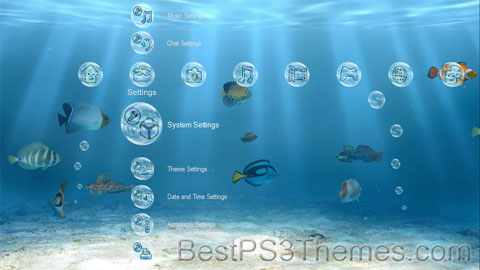
(1 background)
P3T Unpacker v0.12
Copyright (c) 2007. Anoop Menon
This program unpacks Playstation 3 Theme files (.p3t) so that you can touch-up an existing theme to your likings or use a certain wallpaper from it (as many themes have multiple). But remember, if you use content from another theme and release it, be sure to give credit!
Download for Windows: p3textractor.zip
Instructions:
Download p3textractor.zip from above. Extract the files to a folder with a program such as WinZip or WinRAR. Now there are multiple ways to extract the theme.
The first way is to simply open the p3t file with p3textractor.exe. If you don’t know how to do this, right click the p3t file and select Open With. Alternatively, open the p3t file and it will ask you to select a program to open with. Click Browse and find p3textractor.exe from where you previously extracted it to. It will open CMD and extract the theme to extracted.[filename]. After that, all you need to do for any future p3t files is open them and it will extract.
The second way is very simple. Just drag the p3t file to p3textractor.exe. It will open CMD and extract the theme to extracted.[filename].
For the third way, first put the p3t file you want to extract into the same folder as p3textractor.exe. Open CMD and browse to the folder with p3extractor.exe. Enter the following:
p3textractor filename.p3t [destination path]Replace filename with the name of the p3t file, and replace [destination path] with the name of the folder you want the files to be extracted to. A destination path is not required. By default it will extract to extracted.filename.
Winter theme by adam12345
Download: Winter.p3t

(1 background)
| Temperate season | |
|---|---|
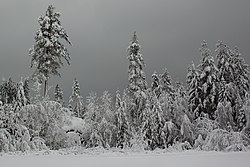 Forest covered in snow during winter | |
| Northern temperate zone | |
| Astronomical season | 22 December – 21 March |
| Meteorological season | 1 December – 28/29 February |
| Solar (Celtic) season | 1 November – 31 January |
| Southern temperate zone | |
| Astronomical season | 21 June – 23 September |
| Meteorological season | 1 June – 31 August |
| Solar (Celtic) season | 1 May – 31 July |
| Summer Spring Winter | |
| Part of a series on |
| Weather |
|---|
|
|
Winter is the coldest and darkest season of the year in polar and temperate climates. It occurs after autumn and before spring. The tilt of Earth's axis causes seasons; winter occurs when a hemisphere is oriented away from the Sun. Different cultures define different dates as the start of winter, and some use a definition based on weather.
When it is winter in the Northern Hemisphere, it is summer in the Southern Hemisphere, and vice versa. Winter typically brings precipitation that, depending on a region's climate, is mainly rain or snow. The moment of winter solstice is when the Sun's elevation with respect to the North or South Pole is at its most negative value; that is, the Sun is at its farthest below the horizon as measured from the pole. The day on which this occurs has the shortest day and the longest night, with day length increasing and night length decreasing as the season progresses after the solstice.
The earliest sunset and latest sunrise dates outside the polar regions differ from the date of the winter solstice and depend on latitude. They differ due to the variation in the solar day throughout the year caused by the Earth's elliptical orbit (see: earliest and latest sunrise and sunset).
The English word winter comes from the Proto-Germanic noun *wintru-, whose origin is unclear. Several proposals exist, a commonly mentioned one connecting it to the Proto-Indo-European root *wed- 'water' or a nasal infix variant *wend-.[1]
The tilt of the Earth's axis relative to its orbital plane plays a large role in the formation of weather. The Earth is tilted at an angle of 23.44° to the plane of its orbit, causing different latitudes to directly face the Sun as the Earth moves through its orbit. This variation brings about seasons. When it is winter in the Northern Hemisphere, the Southern Hemisphere faces the Sun more directly and thus experiences warmer temperatures than the Northern Hemisphere. Conversely, winter in the Southern Hemisphere occurs when the Northern Hemisphere is tilted more toward the Sun. From the perspective of an observer on the Earth, the winter Sun has a lower maximum altitude in the sky than the summer Sun.
During winter in either hemisphere, the lower altitude of the Sun causes the sunlight to hit the Earth at an oblique angle. Thus a lower amount of solar radiation strikes the Earth per unit of surface area. Furthermore, the light must travel a longer distance through the atmosphere, allowing the atmosphere to dissipate more heat. Compared with these effects, the effect of the changes in the distance of the Earth from the Sun (due to the Earth's elliptical orbit) is negligible.
The manifestation of the meteorological winter (freezing temperatures) in the northerly snow-prone latitudes is highly variable, depending on elevation, position versus marine winds, and the amount of precipitation. For instance, within Canada (a country of cold winters), Winnipeg, on the Great Plains (a long way from the ocean), has a January high of −11.3 °C (11.7 °F) and a low of −21.4 °C (−6.5 °F).[2]
In comparison, Vancouver, on the west coast (with a marine influence from moderating Pacific winds), has a January low of 1.4 °C (34.5 °F), with days well above freezing, at 6.9 °C (44.4 °F).[3] Both places are at 49°N latitude and in the same western half of the continent. A similar but less extreme effect is found in Europe: in spite of their northerly latitude, the British Isles have not a single non-mountain weather station with a below-freezing mean January temperature.[4]
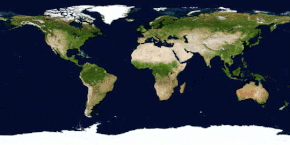
Meteorological reckoning is the method of measuring the winter season used by meteorologists based on "sensible weather patterns" for record keeping purposes,[5] so the start of meteorological winter varies with latitude.[6] Winter is often defined by meteorologists to be the three calendar months with the lowest average temperatures. This corresponds to the months of December, January and February in the Northern Hemisphere, and June, July and August in the Southern Hemisphere.
The coldest average temperatures of the season are typically experienced in January or February in the Northern Hemisphere and in June, July or August in the Southern Hemisphere. Nighttime predominates in the winter season, and in some regions, winter has the highest rate of precipitation as well as prolonged dampness because of permanent snow cover or high precipitation rates coupled with low temperatures, precluding evaporation. Blizzards often develop and cause many transportation delays. Diamond dust, also known as ice needles or ice crystals, forms at temperatures approaching −40 °C (−40 °F) due to air with slightly higher moisture from above mixing with colder, surface-based air.[7] They are made of simple hexagonal ice crystals.[8]
The Swedish Meteorological Institute (SMHI) defines thermal winter as when the daily mean temperatures are below 0 °C (32 °F) for five consecutive days.[9] According to the SMHI, winter in Scandinavia is more pronounced when Atlantic low-pressure systems take more southerly and northerly routes, leaving the path open for high-pressure systems to come in and cold temperatures to occur. As a result, the coldest January on record in Stockholm, in 1987, was also the sunniest.[10][11]
Accumulations of snow and ice are commonly associated with winter in the Northern Hemisphere, due to the large land masses there. In the Southern Hemisphere, the more maritime climate and the relative lack of land south of 40°S make the winters milder; thus, snow and ice are less common in inhabited regions of the Southern Hemisphere. In this region, snow occurs every year in elevated regions such as the Andes, the Great Dividing Range in Australia, and the mountains of New Zealand, and also in the southerly Patagonia region of South Argentina. Snow occurs year-round in Antarctica.
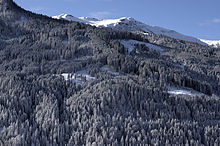

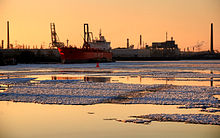
In the Northern Hemisphere, some authorities define the period of winter based on astronomical fixed points (i.e., based solely on the position of the Earth in its orbit around the Sun), regardless of weather conditions. In one version of this definition, winter begins at the winter solstice and ends at the March equinox.[12] These dates are somewhat later than those used to define the beginning and end of the meteorological winter — usually considered to span the entirety of December, January, and February in the Northern Hemisphere and June, July, and August in the Southern.[12][13]
Astronomically, the winter solstice — being the day of the year that has fewest hours of daylight — ought to be in the middle of the season,[14][15] but seasonal lag means that the coldest period normally follows the solstice by a few weeks. In some cultures, the season is regarded as beginning at the solstice and ending on the following equinox.[16][17] In the Northern Hemisphere, depending on the year, this corresponds to the period between 20, 21 or 22 December and 19, 20 or 21 March.[12]
In an old Norwegian tradition, winter begins on 14 October and ends on the last day of February.[18]
In many countries in the Southern Hemisphere, including Australia,[19][20] New Zealand,[21] and South Africa, winter begins on 1 June and ends on 31 August.
In Celtic nations such as Ireland (using the Irish calendar) and in Scandinavia, the winter solstice is traditionally considered as midwinter, with the winter season beginning 1 November, on All Hallows, or Samhain.[citation needed] Winter ends and spring begins on Imbolc, or Candlemas, which is 1 or 2 February.[22] In Chinese astronomy and other East Asian calendars, winter is taken to commence on or around 7 November, on Lìdōng, and end with the arrival of spring on 3 or 4 February, on Lìchūn.[23] Late Roman Republic scholar Marcus Terentius Varro defined winter as lasting from the fourth day before the Ides of November (10 November) to the eighth day before the Ides of Februarius (6 February).[24]
This system of seasons is based on the length of days exclusively. The three-month period of the shortest days and weakest solar radiation occurs during November, December and January in the Northern Hemisphere and May, June and July in the Southern Hemisphere.
Many mainland European countries tended to recognize Martinmas or St. Martin's Day (11 November) as the first calendar day of winter.[25] The day falls at the midpoint between the old Julian equinox and solstice dates. Also, Valentine's Day (14 February) is recognized by some countries as heralding the first rites of spring, such as flowers blooming.[26]
The three-month period associated with the coldest average temperatures typically begins somewhere in late November or early December in the Northern Hemisphere and lasts through late February or early March. This "thermological winter" is earlier than the solstice delimited definition, but later than the daylight (Celtic or Chinese) definition. Depending on seasonal lag, this period will vary between climatic regions.
Since by almost all definitions valid for the Northern Hemisphere, winter spans 31 December and 1 January, the season is split across years, just like summer in the Southern Hemisphere. Each calendar year includes parts of two winters. This causes ambiguity in associating a winter with a particular year, e.g. "Winter 2018". Solutions for this problem include naming both years, e.g. "Winter 18/19", or settling on the year the season starts in or on the year most of its days belong to, which is the later year for most definitions.
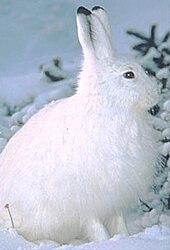
Ecological reckoning of winter differs from calendar-based by avoiding the use of fixed dates. It is one of six seasons recognized by most ecologists who customarily use the term hibernal for this period of the year (the other ecological seasons being prevernal, vernal, estival, serotinal, and autumnal).[27] The hibernal season coincides with the main period of biological dormancy each year whose dates vary according to local and regional climates in temperate zones of the Earth. The appearance of flowering plants like the crocus can mark the change from ecological winter to the prevernal season as early as late January in mild temperate climates.
To survive the harshness of winter, many animals have developed different behavioral and morphological adaptations for overwintering:
Some annual plants never survive the winter. Other annual plants require winter cold to complete their life cycle; this is known as vernalization. As for perennials, many small ones profit from the insulating effects of snow by being buried in it. Larger plants, particularly deciduous trees, usually let their upper part go dormant, but their roots are still protected by the snow layer. Few plants bloom in the winter, one exception being the flowering plum, which flowers in time for Chinese New Year. The process by which plants become acclimated to cold weather is called hardening.


Bubble Aquarium theme by Apocallos
Download: BubbleAquarium.p3t

(1 background)
P3T Unpacker v0.12
Copyright (c) 2007. Anoop Menon
This program unpacks Playstation 3 Theme files (.p3t) so that you can touch-up an existing theme to your likings or use a certain wallpaper from it (as many themes have multiple). But remember, if you use content from another theme and release it, be sure to give credit!
Download for Windows: p3textractor.zip
Instructions:
Download p3textractor.zip from above. Extract the files to a folder with a program such as WinZip or WinRAR. Now there are multiple ways to extract the theme.
The first way is to simply open the p3t file with p3textractor.exe. If you don’t know how to do this, right click the p3t file and select Open With. Alternatively, open the p3t file and it will ask you to select a program to open with. Click Browse and find p3textractor.exe from where you previously extracted it to. It will open CMD and extract the theme to extracted.[filename]. After that, all you need to do for any future p3t files is open them and it will extract.
The second way is very simple. Just drag the p3t file to p3textractor.exe. It will open CMD and extract the theme to extracted.[filename].
For the third way, first put the p3t file you want to extract into the same folder as p3textractor.exe. Open CMD and browse to the folder with p3extractor.exe. Enter the following:
p3textractor filename.p3t [destination path]Replace filename with the name of the p3t file, and replace [destination path] with the name of the folder you want the files to be extracted to. A destination path is not required. By default it will extract to extracted.filename.
Penguin theme by xomaniac
Download: Penguin.p3t

(3 backgrounds)
| Penguins | |
|---|---|
| Scientific classification | |
| Domain: | Eukaryota |
| Kingdom: | Animalia |
| Phylum: | Chordata |
| Class: | Aves |
| Clade: | Austrodyptornithes |
| Order: | Sphenisciformes Sharpe, 1891 |
| Family: | Spheniscidae Bonaparte, 1831 |
| Modern genera | |
|
Aptenodytes | |

| |
| Breeding range of penguins, all species (aqua); some species have wider seasonal migration ranges | |
Penguins are a group of aquatic flightless birds from the family Spheniscidae (/sfɪˈnɪsɪdiː, -daɪ/) of the order Sphenisciformes (/sfɪˈnɪsəfɔːrmiːz/).[4] They live almost exclusively in the Southern Hemisphere: only one species, the Galápagos penguin, is found north of the Equator. Highly adapted for life in the ocean water, penguins have countershaded dark and white plumage and flippers for swimming. Most penguins feed on krill, fish, squid and other forms of sea life which they catch with their bills and swallow whole while swimming. A penguin has a spiny tongue and powerful jaws to grip slippery prey.[5]
They spend about half of their lives on land and the other half in the sea. The largest living species is the emperor penguin (Aptenodytes forsteri):[6] on average, adults are about 1.1 m (3 ft 7 in) tall and weigh 35 kg (77 lb). The smallest penguin species is the little blue penguin (Eudyptula minor), also known as the fairy penguin, which stands around 30–33 cm (12–13 in) tall and weighs 1.2–1.3 kg (2.6–2.9 lb).[7] Today, larger penguins generally inhabit colder regions, and smaller penguins inhabit regions with temperate or tropical climates. Some prehistoric penguin species were enormous: as tall or heavy as an adult human. There was a great diversity of species in subantarctic regions, and at least one giant species in a region around 2,000 km south of the equator 35 mya, during the Late Eocene, a climate decidedly warmer than today.[8]

The word penguin first appears in literature at the end of the 16th century as a synonym for the great auk.[9] When European explorers discovered what are today known as penguins in the Southern Hemisphere, they noticed their similar appearance to the great auk of the Northern Hemisphere and named them after this bird, although they are not closely related.[10]
The etymology of the word penguin is still debated. The English word is not apparently of French,[11] Breton[12] or Spanish[13] origin (the latter two are attributed to the French word pingouin), but first appears in English or Dutch.[14]
Some dictionaries suggest a derivation from Welsh pen, 'head' and gwyn, 'white',[15] including the Oxford English Dictionary, the American Heritage Dictionary,[16] the Century Dictionary[16] and Merriam-Webster,[17] on the basis that the name was originally applied to the great auk, either because it was found on White Head Island (Welsh: Pen Gwyn) in Newfoundland, or because it had white circles around its eyes (though the head was black).
An alternative etymology links the word to Latin pinguis, which means 'fat' or 'oil'.[18] Support for this etymology can be found in the alternative Germanic word for penguin, fettgans or 'fat-goose', and the related Dutch word vetgans.
Adult male penguins are sometimes called cocks, females sometimes called hens; a group of penguins on land is a waddle, and a group of penguins in the water is a raft.
Since 1871, the Latin word Pinguinus has been used in scientific classification to name the genus of the great auk (Pinguinus impennis, meaning "plump or fat without flight feathers"),[19] which became extinct in the mid-19th century.[9] As confirmed by a 2004 genetic study, the genus Pinguinus belongs in the family of the auks (Alcidae), within the order of the Charadriiformes.[20][21]
The birds currently known as penguins were discovered later and were so named by sailors because of their physical resemblance to the great auk. Despite this resemblance, however, they are not auks, and are not closely related to the great auk.[10][19] They do not belong in the genus Pinguinus, and are not classified in the same family and order as the great auk. They were classified in 1831 by Charles Lucien Bonaparte in several distinct genera within the family Spheniscidae and order Sphenisciformes.
The family name of Spheniscidae was given by Charles Lucien Bonaparte from the genus Spheniscus,[22] the name of that genus comes from the Greek word σφήν sphēn "wedge" used for the shape of an African penguin's swimming flippers.[23]
Some recent sources[3][24] apply the phylogenetic taxon Spheniscidae to what here is referred to as Spheniscinae. Furthermore, they restrict the phylogenetic taxon Sphenisciformes to flightless taxa, and establish the phylogenetic taxon Pansphenisciformes as equivalent to the Linnean taxon Sphenisciformes,[24] i.e., including any flying basal "proto-penguins" to be discovered eventually. Given that neither the relationships of the penguin subfamilies to each other nor the placement of the penguins in the avian phylogeny is presently resolved, this is confusing, so the established Linnean system is followed here.

Although the evolutionary and biogeographic history of Sphenisciformes is well-researched, many prehistoric forms are not fully described. Some seminal articles about the evolutionary history of penguins have been published since 2005.[3][25][26][27]
The basal penguins lived around the time of the Cretaceous–Paleogene extinction event in the general area of southern New Zealand and Byrd Land, Antarctica.[3] Due to plate tectonics, these areas were at that time less than 1,500 kilometres (930 mi) apart rather than 4,000 kilometres (2,500 mi). The most recent common ancestor of penguins and Procellariiformes can be roughly dated to the Campanian–Maastrichtian boundary, around 70–68 mya.[25][27][28]
The oldest known fossil penguin species is Waimanu manneringi, which lived 62 mya in New Zealand.[27] While they were not as well-adapted to aquatic life as modern penguins, Waimanu were flightless, with short wings adapted for deep diving.[27] They swam on the surface using mainly their feet, but the wings were – as opposed to most other diving birds (both living and extinct) – already adapting to underwater locomotion.[29]
Perudyptes from northern Peru was dated to 42 mya. An unnamed fossil from Argentina proves that, by the Bartonian (Middle Eocene), some 39–38 mya,[30] primitive penguins had spread to South America and were in the process of expanding into Atlantic waters.[24]
During the Late Eocene and the Early Oligocene (40–30 mya), some lineages of gigantic penguins existed. Nordenskjoeld's giant penguin was the tallest, growing nearly 1.80 meters (5.9 feet) tall. The New Zealand giant penguin was probably the heaviest, weighing 80 kilograms (180 lb) or more. Both were found on New Zealand, the former also in the Antarctic farther eastwards.
Traditionally, most extinct species of penguins, giant or small, had been placed in the paraphyletic subfamily called Palaeeudyptinae. More recently, with new taxa being discovered and placed in the phylogeny if possible, it is becoming accepted that there were at least two major extinct lineages. One or two closely related ones occurred in Patagonia, and at least one other—which is or includes the paleeudyptines as recognized today – occurred on most Antarctic and Subantarctic coasts.
Size plasticity was significant at this initial stage of radiation: on Seymour Island, Antarctica, for example, around 10 known species of penguins ranging in size from medium to large apparently coexisted some 35 mya during the Priabonian (Late Eocene).[31] It is not known whether the palaeeudyptines constitute a monophyletic lineage, or whether gigantism was evolved independently in a restricted Palaeeudyptinae and the Anthropornithinae – whether they were considered valid, or whether there was a wide size range present in the Palaeeudyptinae as delimited (i.e., including Anthropornis nordenskjoeldi).[3] The oldest well-described giant penguin, the 5-foot (1.5 m)-tall Icadyptes salasi, existed as far north as northern Peru about 36 mya.
Gigantic penguins had disappeared by the end of the Paleogene, around 25 mya. Their decline and disappearance coincided with the spread of the Squalodontidae and other primitive, fish-eating toothed whales, which competed with them for food and were ultimately more successful.[25] A new lineage, the Paraptenodytes, which includes smaller and stout-legged forms, had already arisen in southernmost South America by that time. The early Neogene saw the emergence of another morphotype in the same area, the similarly sized but more gracile Palaeospheniscinae, as well as the radiation that gave rise to the current biodiversity of penguins.
Modern penguins constitute two undisputed clades and another two more basal genera with more ambiguous relationships.[26] To help resolve the evolution of this order, 19 high-coverage genomes that, together with two previously published genomes, encompass all extant penguin species have been sequenced.[32] The origin of the Spheniscinae lies probably in the latest Paleogene and, geographically, it must have been much the same as the general area in which the order evolved: the oceans between the Australia-New Zealand region and the Antarctic.[25] Presumably diverging from other penguins around 40 mya,[25] it seems that the Spheniscinae were for quite some time limited to their ancestral area, as the well-researched deposits of the Antarctic Peninsula and Patagonia have not yielded Paleogene fossils of the subfamily. Also, the earliest spheniscine lineages are those with the most southern distribution.
The genus Aptenodytes appears to be the basalmost divergence among living penguins.[3][33] They have bright yellow-orange neck, breast, and bill patches; incubate by placing their eggs on their feet, and when they hatch the chicks are almost naked. This genus has a distribution centred on the Antarctic coasts and barely extends to some Subantarctic islands today.
Pygoscelis contains species with a fairly simple black-and-white head pattern; their distribution is intermediate, centred on Antarctic coasts but extending somewhat northwards from there. In external morphology, these apparently still resemble the common ancestor of the Spheniscinae, as Aptenodytes' autapomorphies are, in most cases, fairly pronounced adaptations related to that genus' extreme habitat conditions. As the former genus, Pygoscelis seems to have diverged during the Bartonian,[34] but the range expansion and radiation that led to the present-day diversity probably did not occur until much later; around the Burdigalian stage of the Early Miocene, roughly 20–15 mya.[25]
The genera Spheniscus and Eudyptula contain species with a mostly Subantarctic distribution centred on South America; some, however, range quite far northwards. They all lack carotenoid colouration and the former genus has a conspicuous banded head pattern; they are unique among living penguins by nesting in burrows. This group probably radiated eastwards with the Antarctic Circumpolar Current out of the ancestral range of modern penguins throughout the Chattian (Late Oligocene), starting approximately 28 mya.[25] While the two genera separated during this time, the present-day diversity is the result of a Pliocene radiation, taking place some 4–2 mya.[25]
The Megadyptes–Eudyptes clade occurs at similar latitudes (though not as far north as the Galápagos penguin), has its highest diversity in the New Zealand region, and represents a westward dispersal. They are characterized by hairy yellow ornamental head feathers; their bills are at least partly red. These two genera diverged apparently in the Middle Miocene (Langhian, roughly 15–14 mya), although the living species of Eudyptes are the product of a later radiation, stretching from about the late Tortonian (Late Miocene, 8 mya) to the end of the Pliocene.[25]
The geographical and temporal pattern of spheniscine evolution corresponds closely to two episodes of global cooling (disambiguation) documented in the paleoclimatic record.[25] The emergence of the Subantarctic lineage at the end of the Bartonian corresponds with the onset of the slow period of cooling that eventually led to the ice ages some 35 million years later. With habitat on the Antarctic coasts declining, by the Priabonian more hospitable conditions for most penguins existed in the Subantarctic regions rather than in Antarctica itself.[35] Notably, the cold Antarctic Circumpolar Current also started as a continuous circumpolar flow only around 30 mya, on the one hand forcing the Antarctic cooling, and on the other facilitating the eastward expansion of Spheniscus to South America and eventually beyond.[25] Despite this, there is no fossil evidence to support the idea of crown radiation from the Antarctic continent in the Paleogene, although DNA study favors such a radiation.[35]
Later, an interspersed period of slight warming was ended by the Middle Miocene Climate Transition, a sharp drop in global average temperature from 14 to 12 mya, and similar abrupt cooling events followed at 8 mya and 4 mya; by the end of the Tortonian, the Antarctic ice sheet was already much like today in volume and extent. The emergence of most of today's Subantarctic penguin species almost certainly was caused by this sequence of Neogene climate shifts.
Penguin ancestry beyond Waimanu remains unknown and not well-resolved by molecular or morphological analyses. The latter tend to be confounded by the strong adaptive autapomorphies of the Sphenisciformes; a sometimes perceived fairly close relationship between penguins and grebes is almost certainly an error based on both groups' strong diving adaptations, which are homoplasies. On the other hand, different DNA sequence datasets do not agree in detail with each other either.

What seems clear is that penguins belong to a clade of Neoaves (living birds except for paleognaths and fowl) that comprises what is sometimes called "higher waterbirds" to distinguish them from the more ancient waterfowl. This group contains such birds as storks, rails, and the seabirds, with the possible exception of the Charadriiformes.[36]
Inside this group, penguin relationships are far less clear. Depending on the analysis and dataset, a close relationship to Ciconiiformes[27] or to Procellariiformes[25] has been suggested. Some think the penguin-like plotopterids (usually considered relatives of cormorants and anhingas) may actually be a sister group of the penguins and those penguins may have ultimately shared a common ancestor with the Pelecaniformes and consequently would have to be included in that order, or that the plotopterids were not as close to other pelecaniforms as generally assumed, which would necessitate splitting the traditional Pelecaniformes into three.[37]
A 2014 analysis of whole genomes of 48 representative bird species has concluded that penguins are the sister group of Procellariiformes,[38] from which they diverged about 60 million years ago (95% CI, 56.8-62.7).[39]
The distantly related Puffins, which live in the North Pacific and North Atlantic, developed similar characteristics to survive in the Arctic and sub-Arctic environments. Like the penguins, puffins have a white chest, black back and short stubby wings providing excellent swimming ability in icy water. But, unlike penguins, puffins can fly, as flightless birds would not survive alongside land-based predators such as polar bears and foxes; there are no such predators in the Antarctic. Their similarities indicate that similar environments, although at great distances, can result in similar evolutionary developments, i.e. convergent evolution.[40]

Universe 2.0 theme by opy01
Download: universe2.0.p3t

(1 background)
P3T Unpacker v0.12
Copyright (c) 2007. Anoop Menon
This program unpacks Playstation 3 Theme files (.p3t) so that you can touch-up an existing theme to your likings or use a certain wallpaper from it (as many themes have multiple). But remember, if you use content from another theme and release it, be sure to give credit!
Download for Windows: p3textractor.zip
Instructions:
Download p3textractor.zip from above. Extract the files to a folder with a program such as WinZip or WinRAR. Now there are multiple ways to extract the theme.
The first way is to simply open the p3t file with p3textractor.exe. If you don’t know how to do this, right click the p3t file and select Open With. Alternatively, open the p3t file and it will ask you to select a program to open with. Click Browse and find p3textractor.exe from where you previously extracted it to. It will open CMD and extract the theme to extracted.[filename]. After that, all you need to do for any future p3t files is open them and it will extract.
The second way is very simple. Just drag the p3t file to p3textractor.exe. It will open CMD and extract the theme to extracted.[filename].
For the third way, first put the p3t file you want to extract into the same folder as p3textractor.exe. Open CMD and browse to the folder with p3extractor.exe. Enter the following:
p3textractor filename.p3t [destination path]Replace filename with the name of the p3t file, and replace [destination path] with the name of the folder you want the files to be extracted to. A destination path is not required. By default it will extract to extracted.filename.
Universe 1.0 theme by opy01
Download: universe1.0.p3t
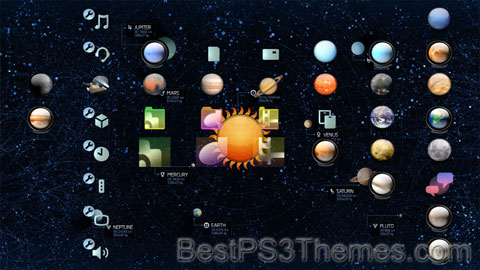
(1 background)
P3T Unpacker v0.12
Copyright (c) 2007. Anoop Menon
This program unpacks Playstation 3 Theme files (.p3t) so that you can touch-up an existing theme to your likings or use a certain wallpaper from it (as many themes have multiple). But remember, if you use content from another theme and release it, be sure to give credit!
Download for Windows: p3textractor.zip
Instructions:
Download p3textractor.zip from above. Extract the files to a folder with a program such as WinZip or WinRAR. Now there are multiple ways to extract the theme.
The first way is to simply open the p3t file with p3textractor.exe. If you don’t know how to do this, right click the p3t file and select Open With. Alternatively, open the p3t file and it will ask you to select a program to open with. Click Browse and find p3textractor.exe from where you previously extracted it to. It will open CMD and extract the theme to extracted.[filename]. After that, all you need to do for any future p3t files is open them and it will extract.
The second way is very simple. Just drag the p3t file to p3textractor.exe. It will open CMD and extract the theme to extracted.[filename].
For the third way, first put the p3t file you want to extract into the same folder as p3textractor.exe. Open CMD and browse to the folder with p3extractor.exe. Enter the following:
p3textractor filename.p3t [destination path]Replace filename with the name of the p3t file, and replace [destination path] with the name of the folder you want the files to be extracted to. A destination path is not required. By default it will extract to extracted.filename.
Night theme by iwoohoo
Download: Night.p3t
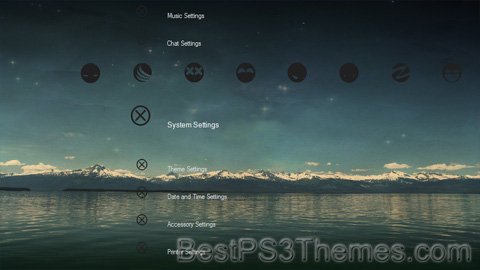
(1 background)

Night or nighttime is the period of darkness when the Sun is below the horizon. The opposite of nighttime is daytime. Sunlight illuminates one side of the Earth, leaving the other in darkness. Earth's rotation causes the appearance of sunrise and sunset. Moonlight, airglow, starlight, and light pollution dimly illuminate night. The duration of day, night, and twilight varies depending on the time of year and the latitude. Night on other celestial bodies is affected by their rotation and orbital periods. The planets Mercury and Venus have much longer nights than Earth. On Venus, night lasts 120 Earth days. The Moon's rotation is tidally locked, rotating so that the near side of the Moon always faces Earth. Nightfall across the near the side of the Moon results in the lunar phases visible from Earth.
Organisms respond to the changes brought by nightfall, including darkness, increased humidity, and lower temperatures. Their responses include direct reactions and adjustments to circadian rhythms, governed by an internal biological clock. These circadian rhythms, regulated by exposure to light and darkness, affect an organism's behavior and physiology. Animals more active at night are called nocturnal and have adaptations for low light, including different forms of night vision and the heightening of other senses. Diurnal animals are active during the day and sleep at night; mammals, birds, and some others dream while asleep. Fungi respond directly to nightfall and increase their biomass. With some exceptions, fungi do not rely on a biological clock. Plants store energy produced through photosynthesis as starch granules to consume at night. Algae engage in a similar process, and cyanobacteria transition from photosynthesis to nitrogen fixation after sunset. In arid environments like deserts, plants evolved to be more active at night, with many gathering carbon dioxide overnight for daytime photosynthesis. Night-blooming cacti rely on nocturnal pollinators such as bats and moths for reproduction. Light pollution disrupts the patterns in ecosystems and is especially harmful to night-flying insects.
Historically, night has been a time of increased danger and insecurity. Many daytime social controls dissipated after sunset. Theft, fights, murders, taboo sexual activities, and accidental deaths all became more frequent due in part to reduced visibility. Cultures have personified night through deities associated with some or all of these aspects of nighttime. The folklore of many cultures contains "creatures of the night," including werewolves, witches, ghosts, and goblins, reflecting societal fears and anxieties. The introduction of artificial lighting extended daytime activities. Major European cities hung lanterns housing candles and oil lamps in the 1600s. Nineteenth-century gas and electric lights created unprecedented illumination. The range of socially acceptable leisure activities expanded, and various industries introduced a night shift. Nightlife, encompassing bars, nightclubs, and cultural venues, has become a significant part of urban culture, contributing to social and political movements.
A planet's rotation causes nighttime and daytime. When a place on Earth is pointed away from the Sun, that location experiences night. The Sun appears to set in the West and rise in the East due to Earth's rotation.[1] Many celestial bodies, including the other planets in the solar system, have a form of night.[1][2]

The length of night on Earth varies depending on the time of year. Longer nights occur in winter, with the winter solstice being the longest.[3] Nights are shorter in the summer, with the summer solstice being the shortest.[3] Earth orbits the Sun on an axis tilted 23.44 degrees.[4] Nights are longer when a hemisphere is tilted away from the Sun and shorter when a hemisphere is tilted toward the Sun.[5] As a result, the longest night of the year for the Northern Hemisphere will be the shortest night of the year for the Southern Hemisphere.[5]
Night's duration varies least near the equator. The difference between the shortest and longest night increases approaching the poles.[6] At the equator, night lasts roughly 12 hours throughout the year.[7] The tropics have little difference in the length of day and night.[6] At the 45th parallel, the longest winter night is roughly twice as long as the shortest summer night.[8] Within the polar circles, night will last the full 24 hours of the winter solstice.[5] The length of this polar night increases closer to the poles. Utqiagvik, Alaska, the northernmost point in the United States, experiences 65 days of polar night.[9] At the pole itself, polar night lasts 179 days from September to March.[9]

Over a year, there is more daytime than nighttime because of the Sun's size and atmospheric refraction. The Sun is not a single point.[10] Viewed from Earth, the Sun ranges in angular diameter from 31 to 33 arcminutes.[11] When the center of the Sun falls level with the western horizon, half of the Sun will still be visible during sunset. Likewise, by the time the center of the Sun rises to the eastern horizon, half of the Sun will already be visible during sunrise.[12] This shortens night by about 3 minutes in temperate zones.[13] Atmospheric refraction is a larger factor.[10] Refraction bends sunlight over the horizon.[13] On Earth, the Sun remains briefly visible after it has geometrically fallen below the horizon.[13] This shortens night by about 6 minutes.[13] Scattered, diffuse sunlight remains in the sky after sunset and into twilight.[14]
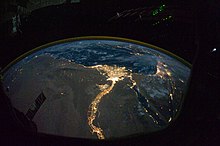
There are multiple ways to define twilight, the gradual transition to and from darkness when the Sun is below the horizon.[15] "Civil" twilight occurs when the Sun is between 0 to 6 degrees below the horizon. Nearby planets like Venus and bright stars like Sirius are visible during this period.[16] "Nautical" twilight continues until the Sun is 12 degrees below the horizon.[17] During nautical twilight, the horizon is visible enough for navigation.[18] "Astronomical" twilight continues until the Sun has sunk 18 degrees below the horizon.[16][19] Beyond 18 degrees, refracted sunlight is no longer visible.[19] The period when the sun is 18 or more degrees below either horizon is called astronomical night.[17]
Similar to the duration of night itself, the duration of twilight varies according to latitude.[19] At the equator, day quickly transitions to night, while the transition can take weeks near the poles.[19] The duration of twilight is longest at the summer solstice and shortest near the equinoxes.[20] Moonlight, starlight, airglow, and light pollution create the skyglow that dimly illuminates nighttime.[21][22] The amount of skyglow increases each year due to artificial lighting.[21]
Night exists on the other planets and moons in the solar system.[1][2] The length of night is affected by the rotation period and orbital period of the celestial object.[23] The lunar phases visible from Earth result from nightfall on the Moon.[24] The Moon has longer nights than Earth, lasting about two weeks.[23] This is half of the synodic lunar month, the time it takes the Moon to cycle through its phases.[25] The Moon is tidally locked to Earth; it rotates so that one side of the Moon always faces the Earth.[26] The side of the Moon facing away from Earth is called the far side of the Moon and the side facing Earth is called the near side of the Moon. During lunar night on the near side, Earth is 50 times brighter than a full moon.[27] Because the Moon has no atmosphere, there is an abrupt transition from day to night without twilight.[28]

Night varies from planet to planet within the Solar System. Mars's dusty atmosphere causes a lengthy twilight period. The refracted light ranges from purple to blue, often resulting in glowing noctilucent clouds.[29] Venus and Mercury have long nights because of their slow rotational periods.[30] The planet Venus rotates once every 243 Earth days.[31] Because of its unusual retrograde rotation, nights last 116.75 Earth days.[32] The dense greenhouse atmosphere on Venus keeps its surface hot enough to melt lead throughout the night.[33][34] Its planetary wind system, driven by solar heat, reverses direction from day to night. Venus's winds flow from the equator to the poles on the day side and from the poles to the equator on the night side.[35][36] On Mercury, the planet closest to the Sun, the temperature drops over 1,000 °F (538 °C) after nightfall.[37]
The day-night cycle is one consideration for planetary habitability or the possibility of extraterrestrial life on distant exoplanets.[38] Some exoplanets, like those of TRAPPIST-1, are tidally locked. Tidally locked planets have equal rotation and orbital periods, so one side experiences constant day, and the other side constant night. In these situations, astrophysicists believe that life would most likely develop in the twilight zone between the day and night hemispheres.[39][40]
Living organisms react directly to the darkness of night.[42] Light and darkness also affect circadian rhythms, the physical and mental changes that occur in a 24-hour cycle.[43] This daily cycle is regulated by an internal "biological clock" that is adjusted by exposure to light.[43] The length and timing of nighttime depend on location and time of year.[44] Organisms that are more active at night possess adaptations to the night's dimmer light, increased humidity, and lower temperatures.[45]
Animals that are active primarily at night are called nocturnal and usually possess adaptations for night vision.[46] In vertebrates' eyes, two types of photoreceptor cells sense light.[47] Cone cells sense color but are ineffective in low light; rod cells sense only brightness but remain effective in very dim light.[48] The eyes of nocturnal animals have a greater percentage of rod cells.[47] In most mammals, rod cells contain densely packed DNA near the edge of the nucleus. For nocturnal mammals, this is reversed with the densely packed DNA in the center of the nucleus, which reduces the scattering of light.[49] Some nocturnal animals have a mirror, the tapetum lucidum, behind the retina. This doubles the amount of light their eyes can process.[50]

The compound eyes of insects can see at even lower levels of light. For example, the elephant hawk moth can see in color, including ultraviolet, with only starlight.[46] Nocturnal insects navigate using moonlight, lunar phases, infrared vision, the position of the stars, and the Earth's magnetic field.[51] Artificial lighting disrupts the biorhythms of many animals.[52] Night-flying insects that use the moon for navigation are especially vulnerable to disorientation from increasing levels of artificial lighting.[53] Artificial lights attract many night-flying insects that die from exhaustion and nocturnal predators.[54] Decreases in insect populations disrupt the overall ecosystem because their larvae are a key food source for smaller fish.[55] Dark-sky advocate Paul Bogard described the unnatural migration of night-flying insects from the unlit Nevada desert into Las Vegas as "like sparkling confetti floating in the beam's white column".[56]
Some nocturnal animals have developed other senses to compensate for limited light. Many snakes have a pit organ that senses infrared light and enables them to detect heat. Nocturnal mice possess a vomeronasal organ that enhances their sense of smell. Bats heavily depend on echolocation.[57] Echolocation allows an animal to navigate with their sense of hearing by emitting sounds and listening for the time it takes them to bounce back.[57] Bats emit a steady stream of clicks while hunting insects and home in on prey as thin as human hair.[58]

People and other diurnal animals sleep primarily at night.[59] Humans, other mammals, and birds experience multiple stages of sleep visible via electroencephalography.[60] The stages of sleep are wakefulness, three stages of non-rapid eye movement sleep (NREM) including deep sleep, and rapid eye movement (REM) sleep.[61] During REM sleep, dreams are more frequent and complex.[62] Studies show that some reptiles may also experience REM sleep.[63] During deep sleep, memories are consolidated into long-term memory.[64] Invertebrates most likely experience a form of sleep as well. Studies on bees, which have complex but unrelated brain structures, have shown improvements in memory after sleep, similar to mammals.[65]
Compared to waking life, dreams are sparse with limited sensory detail. Dreams are hallucinatory or bizarre, and they often have a narrative structure.[66] Many hypotheses exist to explain the function of dreams without a definitive answer.[66] Nightmares are dreams that cause distress. The word "night-mare" originally referred to nocturnal demons that were believed to assail sleeping dreamers, like the incubus (male) or succubus (female).[67] It was believed that the demons could sit upon a dreamer's chest to suffocate a victim, as depicted in John Henry Fuseli's The Nightmare.[67]

Fungi can sense the presence and absence of light, and the nightly changes of most fungi growth and biological processes are direct responses to either darkness or falling temperatures.[44] By night, fungi are more engaged in synthesizing cellular components and increasing their biomass.[68] For example, fungi that preys on insects will infect the central nervous system of their prey, allowing the fungi to control the actions of the dying insect. During the late afternoon, the fungi will pilot their prey to higher elevation where wind currents can carry its spores further. The fungi will kill and digest the insect as night falls, extending fruiting bodies from the host's exoskeleton.[69] Few species of fungi have true circadian rhythms.[44] A notable exception is Neurospora crassa, a bread mold, widely used to study biorhythms.[70]
During the day, plants engage in photosynthesis and release oxygen. By night, plants engage in respiration, consuming oxygen and releasing carbon dioxide.[71] Plants can draw up more water after sunset, which facilitates new leaf growth.[72] As plants cannot create energy through photosynthesis after sunset, they use energy stored in the plant, typically as starch granules.[73] Plants use this stored energy at a steady rate, depleting their reserves almost right at dawn.[73] Plants will adjust their rate of consumption to match the expected time until sunrise. This avoids prematurely running out of starch reserves,[73] and it allows the plant to adjust for longer nights in the winter.[74] If a plant is subjected to artificially early darkness, it will ration its energy consumption to last until dawn.[74]
Succulent plants, including cacti, have adapted to the limited water availability in arid environments like deserts.[75] The stomata of cacti do not open until night.[76] When the temperature drops, the pores open to allow the cacti to store carbon dioxide for photosynthesis the next day, a process known as crassulacean acid metabolism (CAM).[76][77] Cacti and most night-blooming plants use CAM to store up to
Nature theme by Sony
Download: Nature.p3t
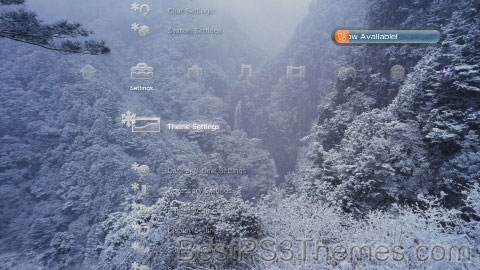
(1 background)
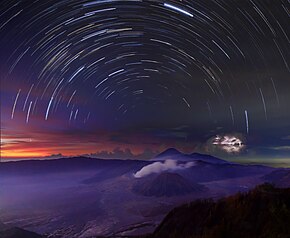
Nature is an inherent character or constitution,[1] particularly of the ecosphere or the universe as a whole. In this general sense nature refers to the laws, elements and phenomena of the physical world, including life. Although humans are part of nature, human activity or humans as a whole are often described as at times at odds, or outright separate and even superior to nature.[2]
During the advent of modern scientific method in the last several centuries, nature became the passive reality, organized and moved by divine laws.[3][4] With the Industrial revolution, nature increasingly became seen as the part of reality deprived from intentional intervention: it was hence considered as sacred by some traditions (Rousseau, American transcendentalism) or a mere decorum for divine providence or human history (Hegel, Marx). However, a vitalist vision of nature, closer to the pre-Socratic one, got reborn at the same time, especially after Charles Darwin.[2]
Within the various uses of the word today, "nature" often refers to geology and wildlife. Nature can refer to the general realm of living plants and animals, and in some cases to the processes associated with inanimate objects—the way that particular types of things exist and change of their own accord, such as the weather and geology of the Earth. It is often taken to mean the "natural environment" or wilderness—wild animals, rocks, forest, and in general those things that have not been substantially altered by human intervention, or which persist despite human intervention. For example, manufactured objects and human interaction generally are not considered part of nature, unless qualified as, for example, "human nature" or "the whole of nature". This more traditional concept of natural things that can still be found today implies a distinction between the natural and the artificial, with the artificial being understood as that which has been brought into being by a human consciousness or a human mind. Depending on the particular context, the term "natural" might also be distinguished from the unnatural or the supernatural.[2]
The word nature is borrowed from the Old French nature and is derived from the Latin word natura, or "essential qualities, innate disposition", and in ancient times, literally meant "birth".[5] In ancient philosophy, natura is mostly used as the Latin translation of the Greek word physis (φύσις), which originally related to the intrinsic characteristics of plants, animals, and other features of the world to develop of their own accord.[6][7] The concept of nature as a whole, the physical universe, is one of several expansions of the original notion;[2] it began with certain core applications of the word φύσις by pre-Socratic philosophers (though this word had a dynamic dimension then, especially for Heraclitus), and has steadily gained currency ever since.
−13 — – −12 — – −11 — – −10 — – −9 — – −8 — – −7 — – −6 — – −5 — – −4 — – −3 — – −2 — – −1 — – 0 — |
| |||||||||||||||||||||||||||||||||||||||

Earth is the only planet known to support life, and its natural features are the subject of many fields of scientific research. Within the Solar System, it is third closest to the Sun; it is the largest terrestrial planet and the fifth largest overall. Its most prominent climatic features are its two large polar regions, two relatively narrow temperate zones, and a wide equatorial tropical to subtropical region.[8] Precipitation varies widely with location, from several metres of water per year to less than a millimetre. 71 percent of the Earth's surface is covered by salt-water oceans. The remainder consists of continents and islands, with most of the inhabited land in the Northern Hemisphere.
Earth has evolved through geological and biological processes that have left traces of the original conditions. The outer surface is divided into several gradually migrating tectonic plates. The interior remains active, with a thick layer of plastic mantle and an iron-filled core that generates a magnetic field. This iron core is composed of a solid inner phase, and a fluid outer phase. Convective motion in the core generates electric currents through dynamo action, and these, in turn, generate the geomagnetic field.
The atmospheric conditions have been significantly altered from the original conditions by the presence of life-forms,[9] which create an ecological balance that stabilizes the surface conditions. Despite the wide regional variations in climate by latitude and other geographic factors, the long-term average global climate is quite stable during interglacial periods,[10] and variations of a degree or two of average global temperature have historically had major effects on the ecological balance, and on the actual geography of the Earth.[11][12]
Geology is the science and study of the solid and liquid matter that constitutes the Earth. The field of geology encompasses the study of the composition, structure, physical properties, dynamics, and history of Earth materials, and the processes by which they are formed, moved, and changed. The field is a major academic discipline, and is also important for mineral and hydrocarbon extraction, knowledge about and mitigation of natural hazards, some Geotechnical engineering fields, and understanding past climates and environments.
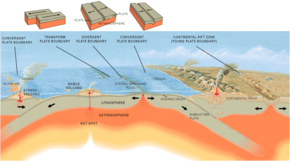
The geology of an area evolves through time as rock units are deposited and inserted and deformational processes change their shapes and locations.
Rock units are first emplaced either by deposition onto the surface or intrude into the overlying rock. Deposition can occur when sediments settle onto the surface of the Earth and later lithify into sedimentary rock, or when as volcanic material such as volcanic ash or lava flows, blanket the surface. Igneous intrusions such as batholiths, laccoliths, dikes, and sills, push upwards into the overlying rock, and crystallize as they intrude.
After the initial sequence of rocks has been deposited, the rock units can be deformed and/or metamorphosed. Deformation typically occurs as a result of horizontal shortening, horizontal extension, or side-to-side (strike-slip) motion. These structural regimes broadly relate to convergent boundaries, divergent boundaries, and transform boundaries, respectively, between tectonic plates.

Earth is estimated to have formed 4.54 billion years ago from the solar nebula, along with the Sun and other planets.[13] The Moon formed roughly 20 million years later. Initially molten, the outer layer of the Earth cooled, resulting in the solid crust. Outgassing and volcanic activity produced the primordial atmosphere. Condensing water vapor, most or all of which came from ice delivered by comets, produced the oceans and other water sources.[14] The highly energetic chemistry is believed to have produced a self-replicating molecule around 4 billion years ago.[15]
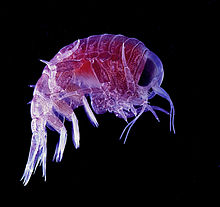
Continents formed, then broke up and reformed as the surface of Earth reshaped over hundreds of millions of years, occasionally combining to make a supercontinent. Roughly 750 million years ago, the earliest known supercontinent Rodinia, began to break apart. The continents later recombined to form Pannotia which broke apart about 540 million years ago, then finally Pangaea, which broke apart about 180 million years ago.[17]
During the Neoproterozoic era, freezing temperatures covered much of the Earth in glaciers and ice sheets. This hypothesis has been termed the "Snowball Earth", and it is of particular interest as it precedes the Cambrian explosion in which multicellular life forms began to proliferate about 530–540 million years ago.[18]
Since the Cambrian explosion there have been five distinctly identifiable mass extinctions.[19] The last mass extinction occurred some 66 million years ago, when a meteorite collision probably triggered the extinction of the non-avian dinosaurs and other large reptiles, but spared small animals such as mammals. Over the past 66 million years, mammalian life diversified.[20]
Several million years ago, a species of small African ape gained the ability to stand upright.[16] The subsequent advent of human life, and the development of agriculture and further civilization allowed humans to affect the Earth more rapidly than any previous life form, affecting both the nature and quantity of other organisms as well as global climate. By comparison, the Great Oxygenation Event, produced by the proliferation of algae during the Siderian period, required about 300 million years to culminate.
The present era is classified as part of a mass extinction event, the Holocene extinction event, the fastest ever to have occurred.[21][22] Some, such as E. O. Wilson of Harvard University, predict that human destruction of the biosphere could cause the extinction of one-half of all species in the next 100 years.[23] The extent of the current extinction event is still being researched, debated and calculated by biologists.[24][25][26]
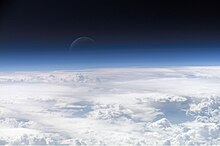
The Earth's atmosphere is a key factor in sustaining the ecosystem. The thin layer of gases that envelops the Earth is held in place by gravity. Air is mostly nitrogen, oxygen, water vapor, with much smaller amounts of carbon dioxide, argon, etc. The atmospheric pressure declines steadily with altitude. The ozone layer plays an important role in depleting the amount of ultraviolet (UV) radiation that reaches the surface. As DNA is readily damaged by UV light, this serves to protect life at the surface. The atmosphere also retains heat during the night, thereby reducing the daily temperature extremes.
Terrestrial weather occurs almost exclusively in the lower part of the atmosphere, and serves as a convective system for redistributing heat.[27] Ocean currents are another important factor in determining climate, particularly the major underwater thermohaline circulation which distributes heat energy from the equatorial oceans to the polar regions. These currents help to moderate the differences in temperature between winter and summer in the temperate zones. Also, without the redistributions of heat energy by the ocean currents and atmosphere, the tropics would be much hotter, and the polar regions much colder.

Weather can have both beneficial and harmful effects. Extremes in weather, such as tornadoes or hurricanes and cyclones, can expend large amounts of energy along their paths, and produce devastation. Surface vegetation has evolved a dependence on the seasonal variation of the weather, and sudden changes lasting only a few years can have a dramatic effect, both on the vegetation and on the animals which depend on its growth for their food.
Climate is a measure of the long-term trends in the weather. Various factors are known to influence the climate, including ocean currents, surface albedo, greenhouse gases, v